A
note-taking
application
is
software
used
for
digital
note
management.
Users
can
create,
edit,
and
organize
their
digital
notes
through
a
note-taking
app.
It
works
as
a
digital
replacement
for
the
pen
and
paper
that
people
use
to
create
to-do
lists,
journals,
set
reminders,
and
more.
These
apps
often
have
a
multi-platform
presence
and
functionality
that
extends
beyond
generic
note-taking
to
cover
real-time
co-editing,
task
assigning,
or
project
management,
making
them
a
worthy
utility
for
individuals
and
businesses
alike.
Our
in-depth
research
and
experience
with
these
apps
helped
us
narrow
down
the
best
note-taking
apps
based
on
their
applicability,
user
interface,
device
compatibility,
and
a
few
more
features,
as
indicated
below.
-
1.
Notion
–
Best
for
Team
Projects -
2.
xTiles
–
Best
for
Visual
Organization -
3.
Evernote
–
All-Round
Note-Taking
for
Personal
and
Business -
4.
Typora
–
Best
for
Distraction-Free
Writing -
5.
Simplenote
–
Free
Personal
Note-Taking -
6.
Todoist
–
Best
for
Task
Management -
7.
OneNote
–
Best
for
Microsoft
Users -
8.
Bear
–
Best
for
Apple
Users -
9.
Notability
–
Best
for
Students -
10.
Google
Keep
–
Best
for
Google
Users -
11.
Standard
Notes
–
Best
for
Privacy-Conscious
Users -
12.
Zoho
Notebook
–
Cross-platform
Note-Taking
Apps -
13.
Goodnotes
–
AI-Assisted
Note-Taking -
Show
less
You
can
trust
Geekflare
Imagine
the
satisfaction
of
finding
just
what
you
needed.
We
understand
that
feeling,
too,
so
we
go
to
great
lengths
to
evaluate
freemium,
subscribe
to
the
premium
plan
if
required,
have
a
cup
of
coffee,
and
test
the
products
to
provide
unbiased
reviews!
While
we
may
earn
affiliate
commissions,
our
primary
focus
remains
steadfast:
delivering
unbiased
editorial
insights,
and
in-depth
reviews.
See
how
we
test.
1.
Notion
Notion’s
features
make
it
one
of
the
most
diverse
apps
on
this
list.
It
can
help
you
take
notes,
clip
webpages,
publish
websites,
manage
projects,
and
optimize
schedules,
among
other
tasks.
However,
Notion’s
core
offering
is
note-taking.
Users
get
support
for
over
50
content
types,
such
as
text,
bullet
points,
equations,
and
code
snippets.
Additionally,
they
can
structure
content
with
a
table
of
contents
and
collapsible
sections.
Nonetheless,
one
of
the
standout
features
is
real-time
collaboration
and
tagging
other
teammates
for
comments.
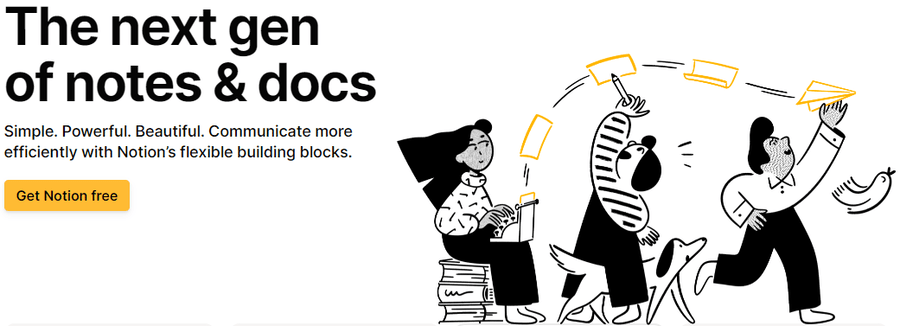
Admins
can
make
access-controlled
spaces
where
members
can
collaborate
and
check
the
version
history
of
any
specific
document
to
keep
track
of
all
the
historical
changes.
Notion
also
allows
users
to
color-code
for
visual
segregation
or
keep
it
simple.
Furthermore,
the
platform
features
a
web
clipper
with
browser
extensions
for
Chrome,
Firefox,
and
Safari.
This
allows
you
to
pick
an
entire
webpage
and
drag
it
anywhere
in
your
workspace.
Later,
you
can
add
notes,
share
them,
or
keep
them
for
future
reference.
Notion
AI
(an
add-on)
makes
the
overall
package
more
potent,
allowing
users
to
ask
questions,
summarize
existing
content,
and
even
write
from
scratch.
It
also
enables
users
to
understand
write-ups,
translate,
or
improve
the
tone
to
suit
the
use
case
or
the
target
audience.
It
offers
a
wide
range
of
integrations,
such
as
Slack,
Canva,
Adobe
XD,
Google
Drive,
One
Drive,
Dropbox,
Box,
Typeform,
Okta,
Trello,
Loom,
and
more.
Teams
can
also
request
specific
integrations.
With
over
2
years
of
hands-on
Notion
experience,
I
have
become
increasingly
dependent
on
it
for
note
organization.
I
recommend
trying
out
Notion
with
its
free
plan
to
see
why
it’s
a
favorite
of
global
teams
of
all
sizes.
Notion
has
an
excellent
cross-platform
presence,
with
native
apps
for
Windows,
Mac,
iOS,
iPadOS,
and
Android
and
a
web
version
for
use
with
a
web
browser.
Notion
Pros
-
Multiple
content
types
covering
text,
visuals,
code,
etc. -
Real-time
collaboration
with
teammates -
Free
tier
with
up
to
10
guests
Notion
Cons
-
Slightly
steep
learning
curve
for
first-timers -
Not
all
features
are
useful
for
note-taking
Notion
Pricing
Notion
has
a
free
tier
offering
space
collaborations,
integrations,
and
more.
However,
larger
businesses
need
to
upgrade
to
the
mentioned
plans
to
unlock
its
true
potential.
-
Plus:
$10/seat/month -
Business:
$15/seat/month -
Enterprise:
Custom
2.
xTiles
xTiles
is
a
multi-purpose
digital
whiteboard
for
taking
notes,
managing
projects
and
schedules,
color-code
tasks,
and
collaborating
with
others
in
real-time.
It
starts
with
a
freeform
white
space
to
create
notes
with
links,
checklists,
images,
files,
tables,
etc.
This
enables
users
with
the
utmost
organizational
flexibility
to
brainstorm
and
work
as
needed.
Subsequently,
users
can
convert
notes
to
tasks,
assign
roles
to
teammates,
and
manage
schedules
in
a
calendar
view.
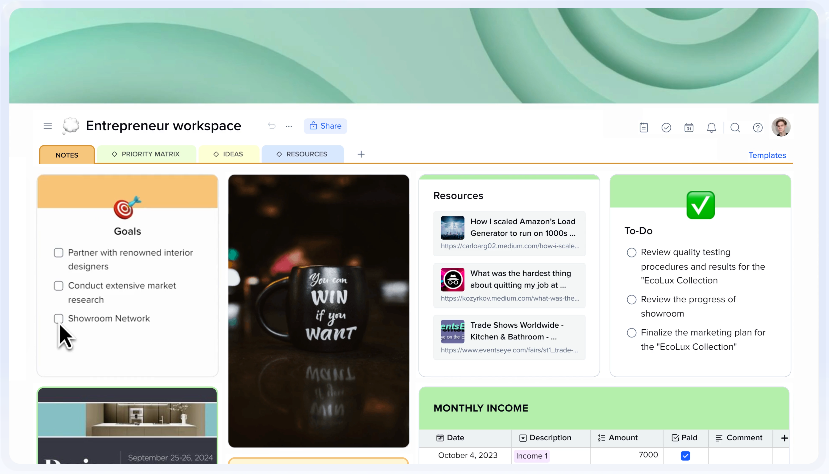
This
note-taking
solution
also
features
a
web
clipper,
which
works
via
a
Chrome
browser
extension
to
save
web
content
directly
into
xTiles
workspaces.
xTiles
caters
to
teams
working
remotely
with
its
collaborative,
shared
workspaces.
These
spaces
allow
admins
to
regulate
access,
which
enables
xTiles
to
function
simultaneously
for
internal
teams
and
external
clients.
Finally,
users
can
share
and
publish
work
with
varied
permissions,
such
as
view-only,
edit,
and
search
engine
indexing.
It
integrates
with
Google
Calendar,
with
connections
for
Google
Drive,
Zapier,
and
Slack
listed
as
coming
soon.
Users
can
deploy
xTiles
from
any
web
browser.
Besides,
it
has
applications
for
Windows,
Mac,
iOS,
iPadOS,
and
Android.
xTiles
Pros
-
Best
for
ideation
with
structuring
flexibility
and
support
to
multiple
content
types -
Shared
workspaces
for
real-time
collaboration -
Free
tier
with
10
teammates
and
unlimited
storage
xTiles
Cons
-
Newly
launched
product
with
a
smaller
userbase
xTiles
Pricing
xTiles’s
free
tier
comes
with
decent
features
for
small
teams,
including
a
10-guest
limit,
100+
templates,
and
unlimited
projects.
For
more,
users
can
subscribe
to
the
below-listed
plans.
-
Starter:
$5/month/user -
Plus:
$8.25/month/user
3.
Evernote
Evernote
was
released
in
2008
and
is
now
considered
a
veteran
of
note-taking
apps.
It
has
plenty
of
features
and
now
covers
notes,
web
clipping,
project
management,
AI-based
search,
collaboration,
and
more,
to
successfully
serve
personal
and
business
use
cases.
It
lets
users
input
information
in
multiple
formats,
including
text,
images,
documents,
scans,
and
audio.
Furthermore,
admins
can
convert
notes
to
tasks
and
add
dates
and
reminders
to
keep
things
on
track.
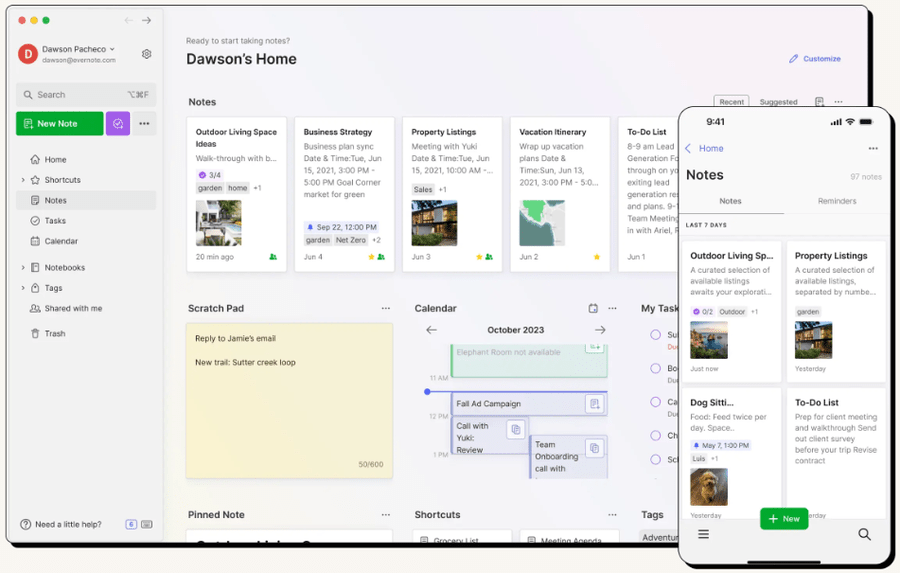
Evernote’s
typo-tolerant
AI
search
lets
users
find
text
across
documents,
including
PDFs,
images,
and
handwritten
notes,
by
using
natural
language
instructions.
It
also
allows
sorting
documents
based
on
keywords,
notes,
or
location.
The
platform’s
real-time
sync
enables
teams
to
collaborate.
It
also
features
spaces
that
admins
can
utilize
to
make
teams
and
keep
everyone
updated.
Furthermore,
people
who
don’t
have
an
Evernote
account
can
receive
notes
from
those
who
use
the
app.
Evernote
allows
integration
tools
like
Gmail,
Slack,
Google
Calendar,
Outlook
Calendar,
Outlook
Email,
and
Google
Drive.
Users
can
sync
between
tools
and
link
relevant
content,
such
as
emails,
documents,
etc.,
for
added
context.
Its
web
clipper
supports
saving
articles
and
web
pages
into
Evernote,
in
part
or
full,
without
distracting
adverts.
Users
can
also
customize
screenshots
with
annotations,
text,
etc.,
to
highlight
important
segments.
This
note-taking
app
also
offers
an
offline
mode,
allowing
users
to
continue
working
even
without
an
internet
connection.
Its
team
version
has
additional
features
such
as
searchable
logs,
SSO,
access
control,
and
more.
Evernote
has
apps
for
Windows,
Mac,
iOS,
iPadOS,
Android,
and
web.
Evernote
Pros
-
Powerful
AI-based
search
working
across
file
formats -
Excellent
sharing
features
without
needing
Evernote
subscriptions -
Offline
access
to
continue
on
local
devices
without
network
connectivity
Evernote
Cons
-
Some
G2
users
foundEvernote
difficult
to
use. -
Can
be
slow
and
laggy,
per
some
user
reviews
Evernote
Pricing
Evernote
free
has
significant
limitations,
such
as
a
50-note
limit
and
single
device
access
only.
Power
users
can
upgrade
to
the
following
tiers
for
more
notes,
unlimited
devices,
and
higher
upload
limits.
-
Personal:
$10.83/month -
Professional:
$14.16/month -
Teams:
$20.83/user/month
4.
Typora
Typora
is
a
distraction-free
interface
for
making
notes
using
Markdown
syntax.
It
has
a
minimalist
interface
yet
supports
a
variety
of
content
formats,
including
text,
headings,
images,
links,
code
blocks,
equations,
tables,
and
inline
styling.
Users
get
a
side
panel
to
organize
Typora
workspace,
which
mentions
local
documents
and
integrated
cloud
services,
such
as
Dropbox
and
iCloud.
Moreover,
each
document
features
an
Outline
Panel
mentioning
clickable
headings.

It
has
two
writing
modes:
focus
and
typewriter.
Focus
blurs
everything
else
other
than
the
active
line
being
written,
whereas
Typewriter
keeps
the
current
line
always
in
the
vertical
middle
of
the
typing
space.
Typora
auto-completes
a
pair
of
quotes
and
brackets
to
further
help
the
writer.
Other
typing
assistance
modes
can
be
switched
on
for
markdown
symbols.
Typora
also
allows
users
to
change
themes,
thereby
providing
maximum
customization
flexibility
with
CSS.
Additionally,
the
platform
supports
importing/exporting
in
popular
document
formats,
including
PDF,
docx,
OpenOffice,
LaTeX,
MediaWiki,
and
Epub.
Typora
has
native
applications
for
desktop
platforms,
including
Windows,
macOS,
and
Linux.
Typora
Pros
-
Clutter-free
writing
space -
Extensive
support
for
various
content
types,
covering
text,
images,
tables,
links,
and
more.
Typora
Cons
-
Lacks
collaboration
features,
restricting
it
only
to
individuals -
Markdown
syntax
can
take
time
to
get
used
to
Typora
Pricing
Typora
offers
a
free
15-day
trial
with
a
3-device
sync.
Users
can
then
purchase
it
for
$14.99.
5.
Simplenote
Simplenote
is
a
100%
free
note-taking
app
for
all
platforms,
and
is
presented
by
the
makers
of
WordPress.
This
app
for
writing
notes
allows
real-time
collaboration,
which
users
can
initiate
by
entering
the
email
of
another
Simplenote
user.
It
also
enables
users
to
share
notes
by
publishing
them
and
later
sharing
the
link
with
others.
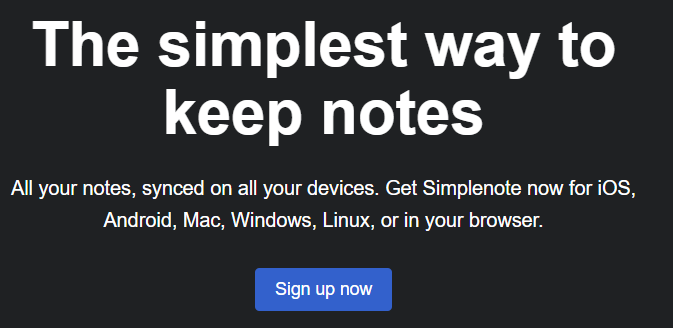
Everything
syncs
automatically
without
the
need
for
manual
intervention.
Users
can
tag
their
notes,
which
helps
them
search
through
their
personal
database.
Simplenote
also
supports
writing,
previewing,
and
publishing
notes
in
Markdown.
However,
its
Markdown
support
is
limited
and
leaves
out
a
few
elements,
such
as
code
blocks,
subscripts,
HTML,
etc.
The
platform
has
apps
for
Windows,
Linux,
iOS,
macOS,
and
Android,
and
they
can
be
used
offline
as
well.
Apart
from
that,
Simplenote
is
also
available
on
web
browsers,
without
any
installation
requirements.
Simplenote
Pros
-
Completely
free
note-taking
app -
Allows
collaboration -
Automated
syncing
to
reduce
workload
Simplenote
Cons
-
Limited
support
to
content
types,
including
on-device
images -
Lacks
business
application -
Markdown
support
is
restricted
Simplenote
Pricing
Simplenote
is
available
completely
free
of
cost.
6.
Todoist
Todoist
is
predominantly
a
task
organizer
and
a
project
manager.
Its
underlying
AI
takes
input
from
natural
language
descriptions
and
fills
the
relevant
fields
on
its
own.
Users
can
add
tasks
and
break
them
into
sub-tasks,
with
a
priority
level.
Todoist
also
enables
users
to
convert
tasks
into
projects
and
set
up
one-time
or
recurring
reminders.
Todoist’s
dashboard
sorts
tasks
based
on
their
due
date
by
default,
and
users
can
also
arrange
them
priority-wise
using
custom
filters.
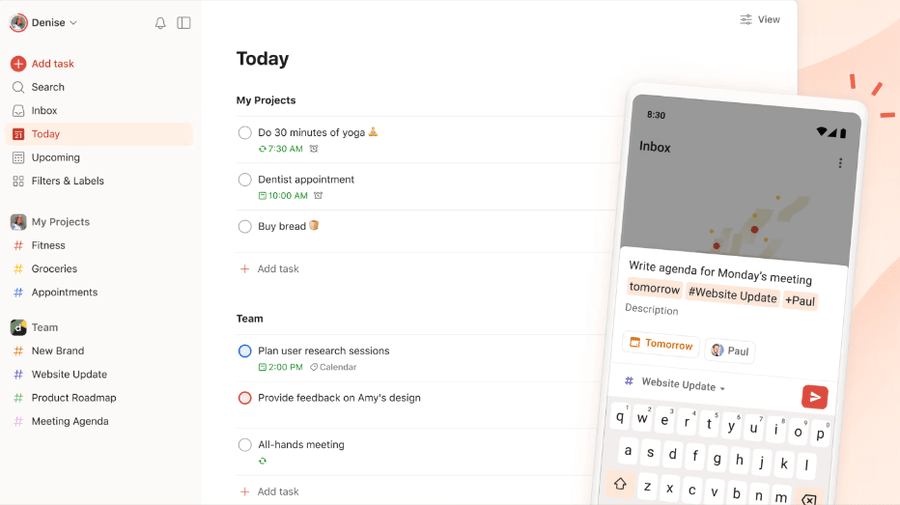
Additionally,
admins
can
invite
their
teams,
assign
responsibilities,
and
set
deadlines.
Members
can
co-work
in
real-time,
including
commenting
and
sharing
files.
The
shared
workspace
allows
changing
layouts
between
list,
board,
and
calendar
views.
Moreover,
teams
can
sort
the
tasks
by
clients,
club
similar
tasks
together,
or
customize
the
template
to
suit
their
preferences.
Todoist
integrates
with
over
80
applications
as
of
this
writing,
including
Evernote
and
Notion
(via
2sync).
When
activated,
every
Todoist
task
creates
a
matching
entry
at
Evernote.
In
a
similar
fashion,
each
Evernote
record
creates
a
fitting
Todoist
task
on
its
own.
So,
while
Todoist
isn’t
a
note-taker
on
its
own,
it
works
alongside
leading
note
applications
with
its
integrations.
Todoist
syncs
across
10
platforms,
including
desktop
(Windows,
macOS,
and
Linux),
mobile
devices
(iOS
and
Android),
wearables
(Apple
Watch
and
Wear
OS),
web
browsers
(Chrome,
Firefox,
Edge,
and
Safari),
and
email
(Gmail
and
Outlook).
Todoist
Pros
-
Understands
natural
language
descriptions -
Extensive
platform
availability -
Free
tier
for
individuals
and
teams
Todoist
Cons
-
Not
a
standalone
note-taking
utility -
Lacks
integrations
with
more
note-taking
apps,
such
as
OneNote.
Todoist
Pricing
Users
can
start
with
the
free
tier,
which
includes
5
personal
projects
and
a
week’s
worth
of
activity
history.
Subsequently,
higher
subscriptions
with
more
projects,
unlimited
history,
AI
assistance,
etc.,
are
listed
below.
-
Pro:
$4/month -
Business:
$6/user/month
7.
OneNote
OneNote
is
a
Microsoft
offering
that
lets
you
take
meeting
notes,
draw,
create
equations,
use
audio/video,
and
do
much
more
in
its
freeform
whitespace.
It
automatically
syncs
in
the
background,
and
you
can
turn
the
functionality
off
to
limit
the
application
to
a
local
device.
It
supports
adding
files
(such
as
Excel
sheets),
taking
screenshots,
inserting
tables,
sending
notes
to
emails,
checking
calendars,
and
finding
historical
revisions.
One
can
also
save
web
pages
into
the
notebooks
with
OneNote
Web
Clipper.

Users
can
share
their
OneNote
“notebooks”
with
others
and
let
them
view
or
edit
them
as
needed.
For
greater
privacy,
you
can
also
password-protect
specific
sections.
OneNote
lets
users
export
its
contents
as
PDF,
docx,
email,
and
attachments.
While
the
best
way
to
use
OneNote
is
in
tandem
with
other
Office
365
apps
(ex.,
Excel,
Outlook),
it
also
works
well
as
a
standalone
app.
Its
free
version
is
feature-rich,
but
some
premium
features,
such
as
high
storage
and
offline
access,
are
reserved
for
users
with
a
paid
Microsoft
365
subscription.
OneNote
has
native
applications
for
Windows,
Android,
iOS,
and
macOS.
It
also
has
a
web
version
anyone
can
use
with
a
web
browser.
Users
have
a
few
integrations
to
connect
OneNote
with
apps
such
as
cloudHQ,
Zapier,
and
Gmail.
OneNote
Pros
-
Feature-loaded
note-taking
software -
Seamless
experience
with
other
Microsoft
Office
apps,
such
as
Excel -
Free
version
does
not
skimp
on
features
OneNote
Cons
-
Limited
collaborative
features -
Some
G2
users
have
experiencedsync
issues
OneNote
Pricing
OneNote
is
completely
free
to
use.
However,
for
$6.99/month,
users
can
subscribe
to
Office
365
Personal,
which
offers
more
storage
and
greater
collaboration
with
the
rest
of
Microsoft
apps.
8.
Bear
Bear
is
an
Apple
Design
Award-winning
note-taking
utility
currently
limited
to
users
in
the
Apple
ecosystem.
It
supports
Markdown
and
is
known
for
its
minimalist
user
interfaces
on
macOS,
iOS,
and
iPadOS.
The
platform
is
compatible
with
a
variety
of
content
formats,
such
as
text,
links,
tables,
checklists,
images,
code,
and
more.
It
also
features
browser
extension
for
Chrome,
Firefox,
and
Safari
to
clip
entire
web
pages.

Its
OCR
(Optical
Character
Recognition)
capable
search
allows
finding
text
inside
images
and
PDFs,
in
addition
to
generic
notes.
Users
can
also
tag
(with
250+
icons)
notes
and
pin
tags
for
simplified
access
and
search.
Additionally,
users
can
utilize
sectional
headings
for
creating
an
outline
and
organizing
their
notes.
One
of
Bear’s
standout
features
is
the
iCloud
sync,
which
promises
security
and
availability
across
Apple
devices.
Users
can
also
put
passwords
for
extra
protection.
Bear
supports
exporting
in
popular
file
types,
such
as
TXT,
Markdown,
RTF,
PDF,
HTML,
DOCX,
and
ePub.
This
note-taking
app
works
both
online
and
offline.
It
also
allows
sharing
notes
with
others.
However,
its
collaborative
features
are
limited
to
sharing,
without
any
real-time
coworking
possibility.
Bear
Pros
-
Great
for
personal
use -
Aesthetically
pleasing
design -
OCR
search
helps
find
text
through
images,
PDFs,
etc.
Bear
Cons
-
Free
version
has
no
syncing
capabilities -
Lacks
business
features
like
team
collaboration,
integrations,
shared
spaces,
etc.
Bear
Pricing
Bear’s
free
version
allows
uses
to
scan
documents
and
provides
local
device
access.
For
everything
else,
users
have
to
opt
for
its
7-day
free
premium
trial.
Afterward,
it
is
$2.99/month
or
$29.99/year.
9.
Notability
Notability
comes
with
powerful
features,
such
as
handwriting
recognition
(converting
handwritten
notes
into
text),
and
has
apps
for
Apple
devices,
including
Mac,
iPhone,
iPad,
and
Vision.
Through
its
features,
you
can
transform
scribbled
math
equations
into
high-resolution
images
and
also
edit
the
underlying
LaTeX
for
high-quality
typesetting.
Notability
also
lets
users
record
audio
and
transcribe
it
into
text
while
keeping
them
in
sync
with
notes.
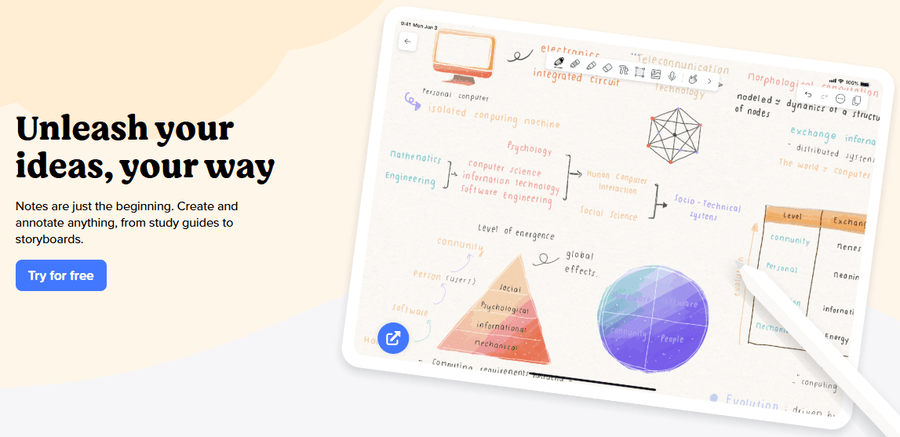
It
enables
everyone
to
search
anything
in
the
notes,
including
handwriting,
audio
transcripts,
and
imported
files
(such
as
PDFs,
DOCs,
PPTs,
GIFs,
etc.).
Furthermore,
this
note-taker
has
a
presentation
mode,
with
a
hidden
second
note
interface
only
visible
to
the
presenter.
Users
can
view
two
notes
at
the
same
time
and
transfer
their
contents
with
a
simple
drag-and-drop.
It
also
supports
PDF
import
and
document
scanning.
You
get
multiple
sharing
and
exporting
options,
including
Notability
Gallery
—
a
place
to
publish
your
work
and
view
and
download
from
others.
Notability
provides
auto-backup
and
sync
across
users’
Apple
devices
via
iCloud.
Notability
Pros
-
Excellent
interface -
Provides
features
to
record
audio
and
transcription -
Has
region-based
pricing
Notability
Cons
-
Lacks
collaboration
features
and
integrations -
Restricted
to
the
Apple
Ecosystem -
Negligible
business
application
Notability
Pricing
A
few
major
drawbacks
of
an
otherwise
great
free
Notability
tier
are
limited
edits,
lack
of
iCloud
sync,
and
absence
of
auto
backup,
among
others.
To
avail
of
these
features,
you
can
subscribe
by
paying
$4.99/month
or
$14.99/year.
10.
Google
Keep
Keep
is
a
free
cross-platform
syncing
note-taker
from
Google,
which
has
apps
for
Android
devices
and
Apple
mobile
operating
systems.
Google
Keep
also
has
web
versions
users
can
utilize
on
web
browsers,
irrespective
of
the
platform.
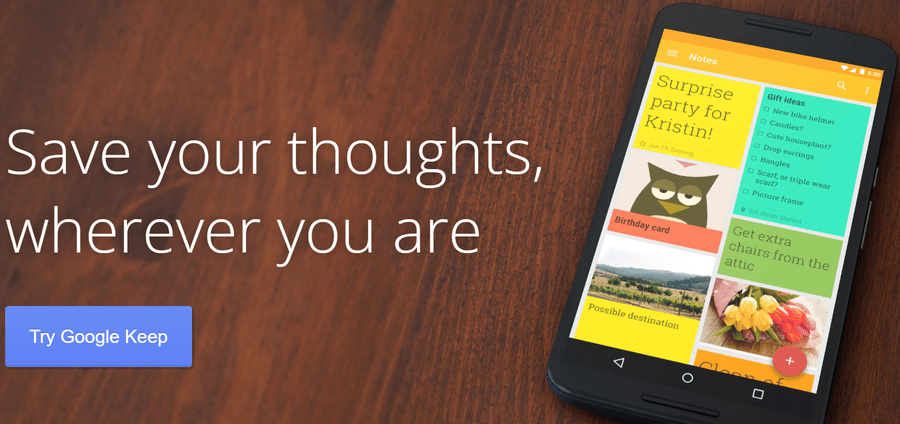
The
interface
is
an
open
space
hosting
all
the
user
notes.
Users
can
tag
and
pin
notes
for
easy
searchability.
Google
Keep
allows
users
to
add
location—or
time-based
reminders.
It
supports
adding
plain
text,
checklists,
images,
drawings,
and
more.
The
platform
also
lets
users
search
notes
with
images,
audio,
reminders,
or
sharing
enabled.
Though
Keep
allows
real-time
“co-working”
on
the
same
document,
the
interface
is
tailored
for
individual
use
cases
and
doesn’t
allow
commenting
or
tagging
collaborators.
Consequently,
it’s
best
suited
for
sharing
with
family
or
friends
rather
than
teamwork
in
a
corporate
setting.
Google
Keep
Pros
-
Free
to
use
with
a
Google
account -
Flexible
reminders
based
on
time
and
location -
Great
for
beginners
needing
basic
note-taking
Google
Keep
Cons
-
Unstructured
note
storage
which
can
quickly
become
unintuitive
for
a
large
number
of
notes -
Extremely
restricted
for
business
use
cases
Google
Keep
Pricing
Google
Keep
is
completely
free
to
use
for
individuals.
However,
users
can
still
upgrade
to
premium
plans,
starting
at
$1.99/month,
for
greater
storage
(100GB)
and
AI
integration.
11.
Standard
Notes
Standard
Notes
is
primarily
used
by
those
who
consider
security
as
a
major
criterion.
It
follows
an
end-to-end
encryption
model,
which
allows
the
notes
to
be
read
only
at
the
user
devices
—
denying
all
third-parties,
including
Standard
Notes
themselves.
Users
also
get
an
encrypted
copy
of
their
entire
text
data
on
their
registered
emails
daily.
For
extra
security,
users
can
protect
their
notes
with
two-factor
authentication
and
password-lock
individual
notes.
Moreover,
this
application
supports
locking
the
entire
interface
with
a
passcode
on
launch
or
using
biometrics
(fingerprints,
FaceID,
etc.)
on
mobile
platforms.

It
allows
uploading
encrypted
files
to
the
cloud
storage,
which
helps
users
store
files,
irrespective
of
their
format,
within
their
notes.
Users
can
also
save
copies
of
their
files
on
their
local
devices.
Moreover,
Standard
Notes
has
put
no
limit
on
the
number
of
devices
or
the
total
storage
(for
premium
versions).
Note
revision
history
is
based
on
the
subscription
plan
and
varies
from
5
days
to
unlimited
(infinite
undo).
This
note
taker
supports
not
only
plain
text
but
also
rich
text
format
(.rtf),
spreadsheets,
checklists,
tokens,
code
snippets,
and
markdown.
While
it
lacks
collaborative
features,
users
can
publish
their
notes
on
Listed,
a
free
blogging
platform
with
a
custom
domain.
Interestingly,
Standard
Notes
can
also
function
as
an
authenticator
app
(much
like
Authy
or
Microsoft
Authenticator)
for
other
apps,
increasing
its
usability.
Standard
Notes
can
work
within
a
web
browser
and
has
apps
for
Windows,
macOS,
Linux,
Android,
and
iOS.
Standard
Notes
Pros
-
PPP
based
pricing -
Subscription
sharing
with
up
to
5
accounts -
End-to-end
encryption -
No
size
limit
on
uploads -
Independently
audited,
open-source
codebase
Standard
Notes
Cons
-
Not
suitable
for
teamwork-based
use
cases -
Users
on
G2
havereported
slowdowns
Standard
Notes
Pricing
Standard
Notes
provides
multiple
features
for
its
free
plan,
including
unlimited
device
sync,
end-to-end
encryption,
daily
email
backups,
offline
access,
and
more.
However,
the
storage
is
limited
to
100MB.
This
restriction
is
removed
through
the
paid
plans.
-
Productivity:
$90/year -
Professional:
$120/year
12.
Zoho
Notebook
Notebook
from
Zoho
keeps
things
simple
and
effective
with
its
minimalist
interface
and
cross-platform
presence,
covering
web
browsers,
macOS,
Windows,
iOS,
Android,
and
Linux.
It’s
compatible
with
text,
checklists,
images,
audio,
documents,
scans,
code,
links,
and
handwritten
notes.
Users
can
also
copy
contents
between
individual
notebooks.
Zoho
Notebook
is
one
of
the
few
in
the
industry
that
offers
gesture
support.
For
instance,
you
can
flick
to
find
or
pinch
to
stack
note
cards.
Another
noteworthy
addition
is
its
AI
assistant,
Zia,
which
lets
users
save
and
search
content
and
set
reminders
with
voice
commands.

Additionally,
users
can
put
tags
and
colors
on
each
note
card,
adding
personality
and
making
search
easy.
Its
emphasis
on
style
becomes
more
evident
with
notebook
colors,
theme
cards,
and
fonts.
Zoho
Notebook
team
features
include
public
and
private
sharing,
mentions,
data
encryption,
project
management,
activity
logs,
and
real-time
collaboration
(with
view
and
edit
permissions),
making
it
perfect
for
business
use
cases
as
well.
Notebook
integrates
with
IFTTT,
Google
Workspace,
Slack,
Zoho
Suite,
Zapier,
Microsoft
Teams,
and
more.
Zoho
Notebook
Pros
-
Gesture
support
and
AI
assistant -
Competitively
priced
paid
plans -
OCR
enabled
search
for
finding
through
images
and
scans
Zoho
Notebook
Cons
-
History
limited
to
the
last
10
versions
for
the
free
tier -
A
few
G2
users
have
found
theUI
to
be
unintuitive
Zoho
Notebook
Pricing
Notebook
Free
limits
its
takers
to
5GB
of
cloud
storage,
a
100MB
file
upload
limit,
and
up
to
10
versions
of
notecards.
To
unlock
more
functions,
users
can
switch
to
economically
priced
subscriptions
starting
at
$1.99/month
or
$19.99/year.
Notebooks
for
Business
has
a
similar
free
offering,
but
its
paid
plans
are
billed
at
$49.90/user/year.
13.
Goodnotes
Goodnotes
provides
AI
assistance
to
help
users
easily
type,
correct
mistakes,
autocomplete
(even
with
handwriting),
and
search
across
documents
(text,
PDFs,
scribbles,
and
more).
It
allows
users
to
both
draw
and
type
to
get
the
most
out
of
their
note-taking
sessions,
and
works
best
with
Apple
Pencil.
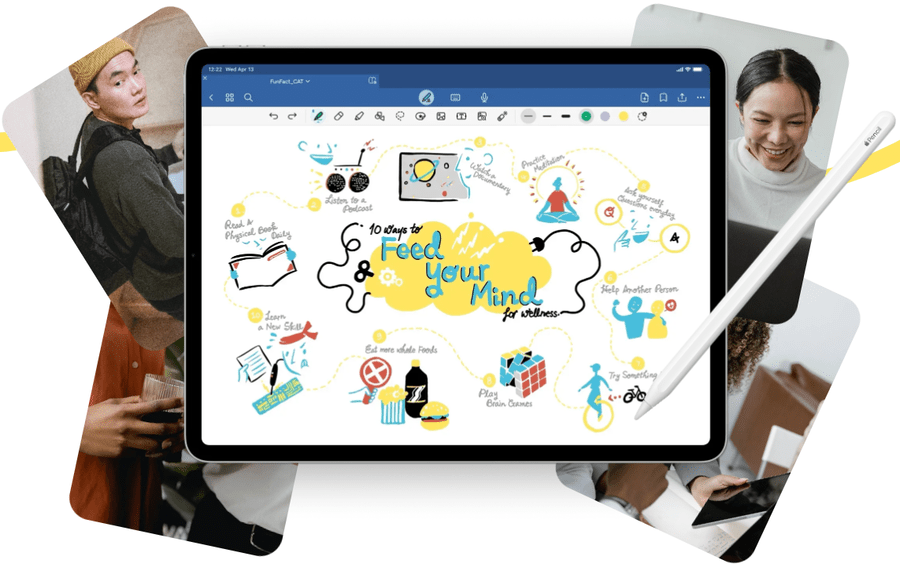
Teams
can
import
PDFs
to
read,
highlight,
fill
out
forms,
or
e-sign.
Goodnotes
also
lets
you
import
audio
and
images.
This
platform
also
has
features
for
students,
including
study
assistance,
turning
notes
into
flashcards
for
quick
recall,
and
keeping
digital
notebooks
for
different
subjects
or
classes.
Goodnotes
can
be
used
on
a
standard
web
browser,
or
users
can
download
its
native
apps
for
macOS,
Windows,
Android,
and
iOS.
Goodnotes
Pros
-
Has
integrated
e-sign
functionality -
Affordably
priced
paid
subscriptions -
Inexpensive
one-time
fee
for
Apple
users
Goodnotes
Cons
-
AI
features
and
audio
recording
are
limited
to
Apple
devices -
No
sync
between
Apple
and
Windows
devices
yet
(listed
as
coming
soon!)
Goodnotes
Pricing
Goodnotes
Free
lets
users
work
with
3
notebooks,
import
files
(up
to
5MB),
share
notes,
record
audio
(Apple
only),
and
use
AI
handwriting
(Apple
only).
Its
paid
features
are
predominantly
available
for
Apple
devices,
with
Windows
and
Android
yet
to
get
access.
-
All
Platform
Yearly:
$9.99/year -
Apple-One
Time
Payment:
$29.99/year -
Android
&
Windows
Yearly:
$6.99/year
Best
Note-Taking
Apps
Comparison
Table
Check
out
the
following
table
to
find
your
next
note-taker
application
based
on
critical
factors,
such
as
platform
presence,
base
pricing,
handwriting
support,
and
syncing
capabilities.
App
Base
Pricing
Platform
Sync
Handwriting
Notion
$10/seat/month
Windows,
Mac,
iOS,
iPadOS,
Android,
&
Web
Free
+
Paid
plans
No
xTiles
$5/month/user
Windows,
Mac,
iOS,
iPadOS,
Android,
&
Web
Free
+
Paid
plans
Yes
(recognition)
Evernote
$10.83/
Month
Windows,
Mac,
iOS,
iPadOS,
Android,
&
Web
Paid
only
Excellent
(typing
and
search)
Typora
$14.99
Windows,
Mac,
&
Linux
Support
third-party
tools,
such
as
iCloud,
Dropbox,
etc.
No
Simplenote
Free
Windows,
Mac,
iOS,
iPadOS,
Android,
Linux,
&
Web
Yes
No
Todoist
$4/month
Windows,
Mac,
iOS,
iPadOS,
Android,
Linux,
WatchOS,
Wear
OS,
&
Web
Free
+
Paid
plans
Excellent
(writing
and
search)
OneNote
$6.99/month
(Microsoft
365
Personal)
Windows,
Mac,
iOS,
iPadOS,
Android,
&
Web
Free
+
Paid
plans
Good
(writing)
Bear
$2.99/month
Mac,
iOS,
iPadOS,
and
WatchOS
Paid
only
Good
(writing)
Notability
$4.99/month
Mac,
iOS,
iPadOS,
and
visionOS
Paid
only
Excellent
(writing
and
search)
Google
Keep
$1.99/month
(Google
One)
iOS,
iPadOS,
and
WatchOS
Free
+
Paid
plans
Basic
(writing)
Standard
Notes
$90/year
Windows,
macOS,
Linux,
Android,
iPadOS,
and
iOS
Free
+
Paid
plans
No
Zoho
Notebook
$1.99/month
Web,
macOS,
Windows,
iOS,
Android,
and
Linux
Free
+
Paid
plans
Basic
(writing)
Goodnotes
$6.99/year
Windows,
Mac,
iOS,
iPadOS,
Android,
&
Web
Free
+
Paid
plans
Excellent
(writing
and
search)
How
Note-Taking
Apps
Help
With
Productivity?
Note-taking
apps
enhance
productivity
by
providing
users
with
multiple
functionalities
inside
a
single
interface
and
integrating
third-party
apps
for
added
versatility.
It
can
include
tagging
teammates,
planning
events,
setting
reminders,
real-time
co-working,
keeping
document
history,
and
more.
Having
separate
installs
for
each
such
task
will
result
in
unnecessary
back-and-forth
for
each
team
member
and
maintenance
overhead
for
admins.
Modern
note-taking
apps,
with
their
native
applications
for
popular
operating
systems
and
device
sync,
reduce
turnaround
time
and
make
information
available
to
all
stakeholders
everywhere.
Tips
to
Use
Note-Taking
Apps
Effectively?
Use
the
following
5
tips
to
increase
the
efficiency
of
your
note-taking
app.
-
Purpose:
No
single
app
is
suitable
for
every
situation.
For
instance,
minimalists
who
know
markdown
will
feel
great
with
Typora,
whereas
teams
needing
a
feature-rich
note-taker
that
supports
multiple
integrations
will
find
Notion
a
great
fit.
So,
it’s
good
to
identify
the
ideal
use
case
before
opting
for
any
notes
app. -
Structure:
The
note-taking
app
of
your
choice
should
have
the
option
to
organize
your
notes
into
folders
and
subfolders.
Basic
note-taking
apps
lack
this
feature,
and
it
can
lead
to
disorganization
of
important
information. -
Diversify:
Modern
note
apps
support
various
content
types.
Plain
and
simple
text
with
a
basic
font
is
better
for
shorter
notes.
However,
for
larger
notes
with
multiple
subfolders,
it’s
important
to
diversify
the
content
to
increase
readability.
Therefore,
use
different
content
formats,
colors,
images,
checklists,
and
more
to
get
the
best
out
of
your
notes. -
Sync
and
Backup:
It’s
important
to
have
multiple
copies
of
your
work
in
digital
format,
and
sync
gives
you
this
flexibility.
However,
having
an
additional
backup
other
than
on
the
same
platform
is
another
critical
factor
for
high-stakes
work. -
Integrate:
Although
note-taking
apps
are
functional
and
versatile,
they
rarely
cover
every
personal
and
business
need.
In
these
cases,
ensure
that
your
note
app
supports
third-party
integrations
to
expand
its
use
cases.
FAQs
Which
app
is
best
for
getting
notes?
Simplenote
is
best
for
individuals
interested
in
getting
the
notes
with
unlimited
device
sync.
It’s
completely
free
and
has
apps
for
popular
operating
systems,
such
as
Windows,
macOS,
iOS,
and
Android.
Which
note-taking
app
is
best
for
you?
Multiple
apps
are
best
suited
for
specific
use
cases.
For
instance,
Notion
is
great
for
teams,
whereas
Google
Keep
and
OneNote
are
best
for
Google
and
Microsoft
users,
respectively.
Likewise,
Standard
Notes
is
suitable
for
privacy-sensitive
work.
Is
Notability
better
than
GoodNotes?
Notability
caters
predominantly
to
the
Apple
ecosystem.
This
app
specializes
in
handwriting
and
transcribing
audio
to
text.
Goodnotes
also
works
great
with
handwritten
notes
and
provides
flashcards
for
students.
However,
it
offers
advanced
features
like
AI
writing
assistance
and
has
a
wider
footprint,
covering
Windows,
Android,
and
Apple
devices.
Therefore,
except
for
audio
transcription,
Goodnotes
has
a
slight
edge
over
Notability.
However,
both
have
free
versions
that
users
can
try
and
choose
the
best
for
their
individual
use
cases.
What
is
better
than
Evernote?
Simplenote
is
better
than
Evernote
for
personal
use
cases.
We
prefer
Notion
over
Evernote
for
teams
at
Geekflare.
Likewise,
Bear
is
best
for
Apple
users.
However,
Evernote
provides
multiple
features
for
both
personal
and
business
use
cases.
Ultimately,
what
is
considered
as
“best”
will
depend
on
the
app’s
use
case.
